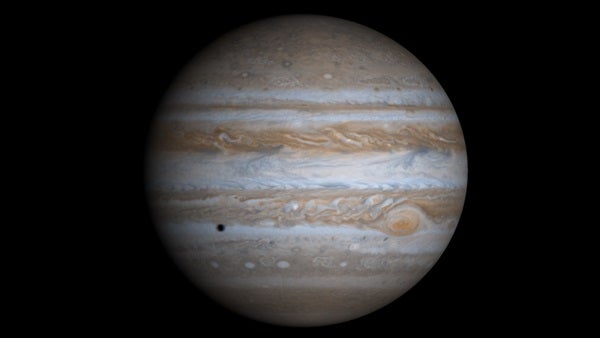Transcript
Welcome to “Tour the solar system.” In this series, we give you an overview of the objects in our neighborhood. This video focuses on Jupiter, the largest planet in the solar system.
Jupiter is typically the fourth-brightest object in Earth’s sky, trailing only the Sun, the Moon, and Venus. It always shines brighter than the brightest star, Sirius, and at its most brilliant beats Sirius by a factor of four. That’s an impressive feat for an object that lies more than 5 times farther from the Sun than Earth does.
It shines so brightly because it’s so big. Jupiter’s equator spans 88,846 miles (142,984 kilometers), more than 11 times Earth’s diameter. More than 1,000 Earths could fit inside this giant planet. And Jupiter contains 318 times Earth’s mass. In fact, it holds twice as much mass as all the other planets in the solar system combined. Despite its vast size, it spins rapidly, completing one rotation in just under 10 hours.
Jupiter is not a rocky sphere like Earth and the other inner planets. Instead, it is a giant ball of gas composed mostly of hydrogen and helium. When you look at Jupiter, you see the upper layers of its massive atmosphere. The cloud tops get sheared into light and dark bands by alternating east and west winds, which blow at tornadic-like speeds of up to 330 mph (530 km/h). High-altitude clouds made mostly of ammonia cover the dark bands, which astronomers call belts. The brighter bands, called zones, are relatively cloud-free.
Giant storms break up the belts and zones. The most famous of these is the Great Red Spot, a high-pressure system that observers first saw more than 300 years ago. This huge storm is more than twice the size of Earth. Its color, which can vary from salmon-pink to brick-red, most likely arises from sulfur compounds dredged up from below by the storm’s intense winds.
Jupiter also has a large family of moons — 63 at last count — but four of them stand out. Italian scientist Galileo discovered Io, Europa, Ganymede, and Callisto in January 1610 when he first turned his crude telescope toward Jupiter. The three inner moons — Io, Europa, and Ganymede — are locked in a tightly choreographed gravitational dance. For every orbit Ganymede makes around Jupiter, Europa orbits twice and Io four times. The rhythmic tugs slightly distort their orbits and, when combined with Jupiter’s strong tidal pull, heat the moons’ interiors.
The effects show up most on innermost Io. This moon, some 5 percent larger than Earth’s Moon, is the most volcanically active world in our solar system. Hundreds of active volcanos dot Io’s surface, which sports multiple shades of orange, yellow, brown, and white that give it a pizza-like complexion. Some volcanos erupt violently, shooting debris hundreds of miles into space; others simply radiate heat as their lava cools.
Europa, the smallest Galilean satellite, has a diameter 90 percent that of our Moon. Its outer layers are almost pure water. Because Europa lies farther from Jupiter than Io does, tidal heating is less, and the water near the surface is frozen solid. But a few miles beneath the ice, the water becomes liquid. Scientists estimate that Europa has a global ocean perhaps 100 miles (160 km) deep and a volume dwarfing that held in all of Earth’s oceans. Europa’s surface features a vast network of cracks and fractures that in some cases span the globe. In other regions, huge blocks of ice jumble together. All these features support the idea that the moon’s icy surface is weak and an ocean lies below.
The next moon outward from Jupiter is Ganymede. The solar system’s largest satellite, Ganymede has a diameter 8 percent larger than the planet Mercury. On this world, reduced tidal heating means the outer ice layer extends halfway to the core. Long parallel grooves cut across parts of Ganymede’s surface, likely the result of an early epoch of internal heating. Impact craters abound in older regions.
The outermost Galilean moon, Callisto, is the solar system’s third largest and just a hair smaller than Mercury. Callisto shows no signs of internal heating, either now or in the past. The most heavily cratered object in the solar system, this moon’s surface is saturated with impact craters. The largest of these impact scars forms a bull’s-eye pattern of concentric ridges spanning about 1,200 miles (1,900 km).
I hope this overview taught you a bit more about Jupiter and its moons. Astronomy’s editors will continue our tour of the solar system in upcoming videos. And make sure to check out issues of Astronomy magazine, which often include articles and news about objects in our solar system.











